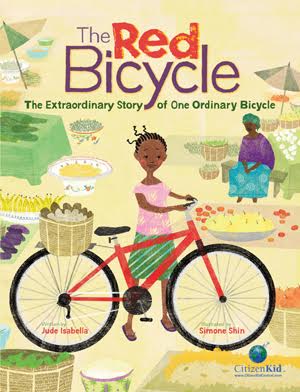| ________________
CM . . .
. Volume XXII Number 2. . . .September 11, 2015
excerpt:
When Leo, living in North America, grows too big for his prized bicycle, fondly named Big Red, he donates it to an organization that collects and sends used bikes to people in Africa who cannot afford to buy them, but who need them for transportation. Alisetta, a young girl, is Big Red’s proud new owner. Having a bike is life-changing for Alisetta and her family as she uses it to ward off birds in the sorghum fields, thereby having more sorghum to harvest. She can also carry goods to market to sell, and she can give her siblings a ride to school. Eventually, when the bicycle is slightly damaged, Alisetta sells it to Boukary, a man who works at a medical clinic that sends health workers to examine and treat sick people in villages that have no doctors or nurses. With the addition of a trailer equipped with a canopy and a portable stretcher, the bicycle becomes a much-needed ambulance. Part of the “CitizenKid” series, which is designed to inspire children to become better global citizens, this book shows readers the far-reaching effects of a simple bicycle, a vehicle which most North American kids probably take for granted. The text is easy to comprehend, and the digitally composed illustrations, rendered mainly in muted tones of gold and soft blue, were inspired by the artist’s early silkscreened artwork, incorporating “elements of real acrylic and silkscreened textures”. They not only suit the text but also provide details of everyday life in Burkina Faso. The one minor flaw is that on each double-page spread, there is a single sentence (separate from the main body of the text) summing up the text on those pages. This sentence is printed in colour in a large size. Sometimes it appears along the top of the page, sometimes along the bottom or side, and often is barely discernible if one isn’t looking for it. This does not really add anything to the text and, though not off-putting, its inclusion is unnecessary. The Red Bicycle: The Extraordinary Story of One Ordinary Bicycle could spark some good discussion in a classroom and, perhaps, lead to social activism. Recommended. Gail Hamilton is a former teacher-librarian in Winnipeg, MB.
To comment
on this title or this review, send mail to cm@umanitoba.ca.
Copyright © the Manitoba Library Association. Reproduction for personal
use is permitted only if this copyright notice is maintained. Any
other reproduction is prohibited without permission.
Next Review |
Table of Contents for This Issue
- September 11, 2015. |
